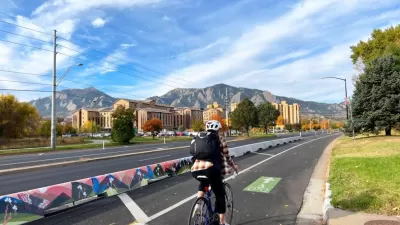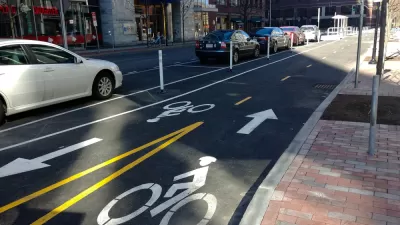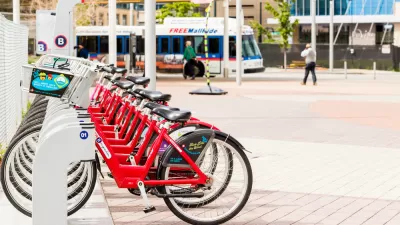Boulder, Colorado may be one of the most bike-friendly cities in the U.S., but that did not stop the City Council on Tuesday night from voting to remove the protected bike lanes on Folsom street and return the road to four lanes of vehicle traffic.
So much for the Folsom Street road diet—it gained its weight back with the Sept. 29 vote by the City Council to return to its hefty four lanes on four blocks in spite of positive evaluation results [PDF] presented at an earlier study session. With that decision, the city, which prides itself as being bike-friendly, may have become just a little less so.
What contributed to the council's decision to remove the protected bike lanes was "the intense backlash from drivers who faced traffic jams, especially during the afternoon rush hour," writes Erica Meltzer for the Daily Camera. However, council was also approving the city staff's recommendation to scale back the project.
"The Living Laboratory street projects involve installing different types of bike lanes and parking arrangements on small segments of streets to test the impact," wrote Meltzer in July.
The Phase II projects take streets with relatively high traffic volumes and two lanes in each direction and replace those lanes with wider bike lanes, painted buffer lanes and one lane of vehicle traffic in each direction with a center turn lane.
Kathleen Bracke, manager of Go Boulder, "said the average delay was just 76 seconds on the southbound side, but travel times were highly variable and some trips took much longer," writes Meltzer.
According to staff's recommendation, "The most noteworthy change would restore Folsom Street to its pre-Living Lab lane configuration from Canyon Boulevard to Spruce Street, returning that stretch of road to a four-lane street. The change is intended to improve vehicular traffic operations along this portion of the Folsom corridor, including at its intersections with Pearl Street and Canyon Boulevard."
Meltzer goes on to write about the "vitriolic tone" of the Tuesday night meeting.
Councilwoman Lisa Morzel, who pushed for the city to roll back the right-sizing project, said the tone of the debate had set back the cause of bicycle infrastructure, and she criticized bicycle advocates dressed in black who were tweeting about the meeting from the front row.
Protected bike lanes will remain on the other parts of Folsom Street, and "staff will continue to collect data such as vehicle volume and speed, travel time through the corridor at peak travel times, the number and type of collisions, the amount of bicycle and pedestrian traffic, and traffic diverted to other streets," notes the press release.
Michael Andersen, Green Lane Project staff writer PeopleForBikes, writes in Streetsblog that Boulder became "the fourth U.S. city to remove a modern protected bike lane."
The others are Memphis, where a riverside project was removed this year after the end of a one-year pilot; Boise, where a downtown network was removed last year after the end of a one-month trial; and Portland, Oregon, where in 2012 the city decided not to replace a series of posts that had been torn out by car collisions on one of its bridges.
However, those reversals are aberrations. "As of last month, 75 U.S. cities (including Memphis, Portland and Boulder) have built permanent protected bike lanes, and the number of such projects is doubling every two years or so," he adds.
FULL STORY: Decrying 'vitriol,' Boulder council decides Folsom will return to 4 lanes

Trump Administration Could Effectively End Housing Voucher Program
Federal officials are eyeing major cuts to the Section 8 program that helps millions of low-income households pay rent.

Planetizen Federal Action Tracker
A weekly monitor of how Trump’s orders and actions are impacting planners and planning in America.

Ken Jennings Launches Transit Web Series
The Jeopardy champ wants you to ride public transit.

Rebuilding Smarter: How LA County Is Guiding Fire-Ravaged Communities Toward Resilience
Los Angeles County is leading a coordinated effort to help fire-impacted communities rebuild with resilience by providing recovery resources, promoting fire-wise design, and aligning reconstruction with broader sustainability and climate goals.

When Borders Blur: Regional Collaboration in Action
As regional challenges outgrow city boundaries, “When Borders Blur” explores how cross-jurisdictional collaboration can drive smarter, more resilient urban planning, sharing real-world lessons from thriving partnerships across North America.

Philadelphia Is Expanding its Network of Roundabouts
Roundabouts are widely shown to decrease traffic speed, reduce congestion, and improve efficiency.
Urban Design for Planners 1: Software Tools
This six-course series explores essential urban design concepts using open source software and equips planners with the tools they need to participate fully in the urban design process.
Planning for Universal Design
Learn the tools for implementing Universal Design in planning regulations.
Ada County Highway District
Clanton & Associates, Inc.
Jessamine County Fiscal Court
Institute for Housing and Urban Development Studies (IHS)
City of Grandview
Harvard GSD Executive Education
Toledo-Lucas County Plan Commissions
Salt Lake City
NYU Wagner Graduate School of Public Service





























